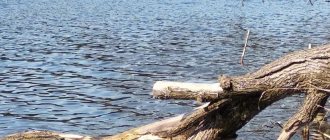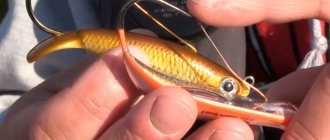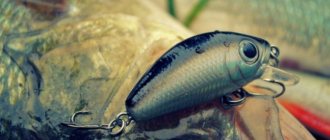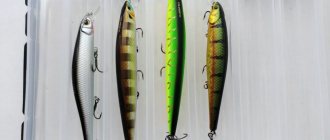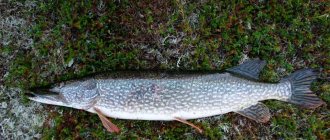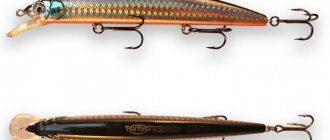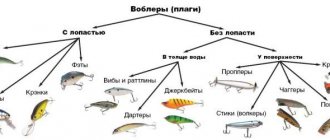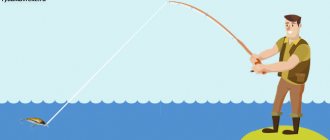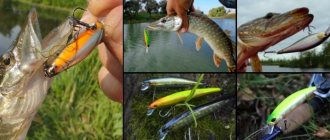Pike fishing in snags
Finding snags on an unfamiliar body of water can be difficult . To do this, you can explore the water area on a boat with an echo sounder . But in some cases, snags protrude directly above the surface of the water.
This often happens on reservoirs , when the remains of flooded trees are clearly visible, and in such a situation there is no need to explore the reservoir in search of a promising point.
If you are going to fish in snags, you need to choose the right gear . To prevent the pike from tangling the equipment after biting, it must be quickly moved away from the bottom debris. This will require a powerful rod and thick fishing line. A strong spinning rod is one of the most important conditions for successful fishing among snags. When using braided fishing line with a high breaking load, you can tear the bait out of the hooks, and in this case the losses will be minimal .
Selection of baits
The following are good for catching pike in snags :
- non-snagging spinners;
- spinnerbaits;
- jig baits.
The spoon has been and remains one of the most popular lures for pike fishing. It also works well in snags, but it is better to use non-snagging . A classic oscillating spoon of this type is equipped with a soldered double, which is protected by a pair of wire whiskers.
The antennae protect the bait from getting caught on snags. At the same time, the pike bends them at the moment of biting and, as a result, sits on the hook after hooking. The percentage of bites realized when fishing with such spoons is less than when fishing with conventional spoons, but this is a common drawback of all hook-on baits.
The main thing is that such spoons allow you to catch snags with minimal loss of bait.
Spinnerbaits are not used often, but they attract pike well easily pass through snags. A wire corner, called a rocker, reliably protects the hook from bottom obstacles. During retrieval, the bait creates noise and vibrations due to the rotation of the petal and the swaying of the skirt, attracting a predator even from long distances.
Jig baits are inexpensive, so you don’t mind losing them. At the same time, you can create a reliable non-snagging hook using offset hooks. Worms are better suited for this, but you can also use classic vibrotails and twisters . Another option is foam rubber , which is used more often for catching pike perch, but also attracts pike .
Other baits :
- spinners;
- oscillating spoons with open hooks;
- wobblers.
care must be taken when wiring to reduce the number of snags to a minimum.
Spinning in river snag
Once I was fishing on a small river, and a thought suddenly occurred to me: why are there no other fishermen nearby? Although on the way to the river I saw that on the floodplain oxbow lakes there were a lot of fans of both spinning rods and fishing rods. I was so overcome with curiosity that I had to walk back half a kilometer to the nearest oxbow lake to ask fellow hobbyists about the reasons for this. What added to the bewilderment was that their catches included small perch and small pike weighing 300-400 grams each. To my question: “Why do you fish not on the river, but here, because the fish are small?” “I received an amazing answer: “What should I do there, tear off the hooks?!” The fear of losing the bait due to snags is the main reason why many spinning anglers avoid snags in rivers. And, in my opinion, in vain. After all, snags on the river are the very places where, first of all, you need to cast, because this is where there is a chance to catch the largest fish.
Let's try to determine the reasons why a huge mass of fishermen ignore snags in rivers. The first one has already been named - this is a high probability of losing baits on hooks. The second, and no less significant, is the inaccessibility of such places. Usually the situation is like this: if there are snags below, in the water, then there are impassable thickets on the shore. And few people want to wade through them. On the plus side is the inconvenience of casting, thorns, nettles, etc. And if a spinning player has a boat, this also poses certain difficulties with assembling and disassembling, launching it into the water, etc. What can be said about this? There’s only one thing: you can’t even take a fish out of the pond without difficulty. This is just about our case, fishing in snags is labor.
Driftwood, they are different
The object of my attention is rivers, primarily medium and small ones. Let's figure out how we can fish with them in difficult conditions of interweaving branches and trunks, and how not to be afraid of such places? Many have probably noticed that at some points on the river a stable predator bite is observed throughout the entire season, but at some points that seem to be similar in type, there are no bites at all. The same is true with driftwood.
A river is a current, strong or weak, but it is always there. Tree trunks and coastal bushes that have fallen into the water weaken this very current. This is especially true for rivers with serious flow speeds. Fish, predatory or peaceful, willy-nilly must look for places with weakened currents, simply to rest or feed. There is one more thing that attracts a predator to snags. A pile of branches and trunks is simply an ideal place for an ambush. Carefully positioning itself in the subsiding current behind a fallen tree, a pike can wait for hours for a gaping fish - and then attack from cover. Thus, the toothy one, as it were, kills two birds with one stone - it stands in a quiet place, without wasting energy fighting the current, and at the same time hunts to replenish this same energy. Effective? Yes, everything is rationally thought out in nature.
The scenario may be slightly different. Why, in a river with a very slow current, when it is practically not felt, would a predator go to the snags, because it does not need to fight the flow at all? Just to hide. Ambush is the main goal of a predator in a snag. Of course, this pattern of behavior is inherent mainly in pike. But both perch and pike perch do not hesitate to hunt for fry from cover, moving from snag to snag.
Why is there a predator behind some snags, but not behind others? Let's imagine a situation - a river, a current, along the banks there are thickets of bushes, a forest. All this is sooner or later washed away by the stream and falls into the water, but not every fallen tree or bush forms a good place. Successful not for us, but for the predator. In my opinion, the first and only condition for the presence of a pike or perch behind a tree or bush that has fallen into the water is the presence of small fish there. If there is none, then there will be no predator. So what you need to look for is not pike (we practically cannot see it in the river), but “white” fish. Of course, there are modern devices for this - echo sounders and structure scanners, but since we are talking about coastal fishing, polarized glasses will help us find “white” fish. They allow you to cut off the glare of the sun from the water and see more clearly what is happening there, behind the surface of the water in the depths. This property is especially evident if the water is clean, and in the autumn it usually is. But even if the water is not crystal clear, then if we are a little more attentive, we will still easily notice small fish scurrying around in the near-surface layer.
Read: Twitch wobblers. Selecting a rod for jerking
In general, the tactics are simple. We walk along the shore and look out for snags. If an interesting place forms behind it, then, as a rule, it is not extended, only a few meters. Now it’s worth stopping and observing for a few minutes. If a small fish scurries around a snag, circles spread out and you can see small fish - bleak, dace, etc., then you can safely linger here. The chances of a predator biting in this place are high. This is especially true from mid-autumn until freeze-up. At such times, all the fish concentrate in certain places and searching for such places is one of the conditions for successful fishing.
How not to be afraid to throw where others do not advise
Let's assume that we found the fish. But what to do next, and, most importantly, what to catch it with? When we fish in snags, our eyes stumble upon branches sticking menacingly out of the water - and our mind literally resists casting the bait. There may be several options for equipment for fishing among snags. Here I offer fishing methods that I have tried myself, and from my own experience I speak about their effectiveness. Let's try, as they say, to set priorities.
The first, and probably the most basic way of fishing in such places is jig. It's simple, fast, mobile and non-sticky. Spinners went to all sorts of tricks to protect the hook from contact with snags. These are wire “whiskers” on the jig head, and special bends on the silicone body of the bait in which the hook was hidden. I liked the “oblique installation” better. The principle is this: we take the most ordinary jig head and pierce the body of the twister with a hook at the very beginning, then we pierce the bait again, but we do not take the hook out, but leave it inside. This went on for several years until, in the early 2000s, offset hooks became available to the mass Russian fisherman. And now almost all fishing trips where a non-snacking rig is needed are carried out with an offset rig. With it you can fish in the most remote snags and not be afraid of tearing off the bait. It’s impossible to say that there will be no snags at all, but if there are any, they will be minimal. The principle of constructing a jig rig in our case will be as follows: a metal leash, an eared weight, popularly called a “Cheburashka”, an offset hook, and a silicone bait.
The next installation method is the so-called Texas equipment. We leave the same four components of the gear as in the previous equipment, only instead of the “Cheburashka” we take a lead or some other “bullet” with a hole in the middle and string it on a metal leash. This increases the snag-freeness of the tackle, if not to 100, then to 99.9% exactly. Due to the fact that the “bullet” does not have any external protruding elements, its maneuverability among branches and various other “wood” is very high.
Simple wacky
There are situations when pike and perch refuse to attack the jig and its Texas modification. Then you can offer a secret weapon - the wacky rig. “Secret” not in the sense that no one knows it, but in the sense that few people use it. There were publications in magazines, articles and videos on the Internet, but wacky never gained popularity among us. For snags, this fishing method is very suitable. Although it is impossible to say that it does not cling to branches and snags. It clings, especially in its classic version, with an open hook. I slightly changed the classic “wacky” rig, making it so that it was convenient to quickly switch from one fishing method to another - for example, from a wecky to a jig, and vice versa. Let me explain. The traditional “weki” uses a special hook: either open or protected from snags by special plastic whiskers. However, these same hooks can not be found in the assortment of every fishing store, even on the Internet, not to mention provincial shops. I had such hooks, I actively used them, but on one of the fishing trips I discovered that I had forgotten these special hooks. And I decided to try to attach a silicone bait using the “wacky” principle, piercing it in the middle with a regular 3-gram jig head. On that fishing trip I caught a good perch, plus there were several more contacts of pike. In general, such a simple installation works, and if it does its job, then why complicate it? So it happened: if I need to lower the bait vertically and slowly play it near the snag, I remove the silicone bait from the “offset” or the hook of the jig head, attach it from the middle - and forward (photo 8). I use light jig heads - 2 - 5 g, depending on the current. Of course, there are some nuances here. Firstly, the mass of the lead weight should be much less, as if we were fishing with a jig in the same place. Otherwise, you won’t get a high-quality “game” of the bait - it will simply fall down like a stone, and even a fast pike won’t have time to react. The second point is that when using a jig head in this equipment, there is a poor implementation of bites. At least, that's my opinion. You have to be on the alert all the time, but if you get lazy, the predator’s attack ends in nothing. But how many emotions such fish coming to the bait bring. Fishing in autumn light water is literally under your feet, and with polarized glasses you can clearly see the shadow of the fish, hit in the hand, then it’s all up to you.
Read: Spinning light and its features
Wiring nuances
We have decided on the technical equipment for snags, and now we will try to answer the question - how to catch? In general, the placement of the bait will differ significantly depending on the type of river you are fishing on: rivers with a slow current will have their own characteristics, and rivers with a fast current will have their own. Let's try to simulate some of the nuances of fishing.
So, the location of the fish has been determined. What to do next? Usually on rivers the snag is compact: it is either a bush that has fallen into the water or a tree. Less common are sections of the river whose banks are completely covered with fallen trees. In the current, we are unlikely to be able to complete a full-fledged long retrieve of several tens of meters. Therefore, even if the snag is extensive, it is best to focus on fishing specific points, rather than throwing bait in an unknown direction and trying to fish “in areas”; such tactics are unlikely to bring many bites. The fact is that on a river where there is a decent current, behind almost every bush or tree that has fallen into the water, an area of quiet water forms, and this is where you can expect an attack from a predator. You should always start with a jig; it will also act as a scout, and if pike and perch are active, it will certainly bring a bite. We try to cast downstream or at an angle to it. If you cast upward, the bait will be carried under the snag by the stream, then even an offset hook will not protect it from the inevitable snag. But on slow-flowing rivers it is possible and even necessary to fish in areas. If there are also serious depths in such a quiet river, then it is not always possible to recognize snags, because some of them are hidden under water, and due to the slow speed of the flow, there is no disturbance on the surface - and it is difficult for us to understand whether there is a snag there or not. For such situations, the jig will act as a scout; by feeling it in our hand, we identify underwater snags and begin to purposefully fish for them.
Read: Catching brook trout with a crayfish imitation
If the jig does not bring a bite, then there may be options: either you move to the next point and fish it and so on in search of an active predator, or you try to “persuad” the fish here by changing the method of presenting the bait. You can try to use the same jig, but hold it not in the classic “step” way, but in the American style. After casting under the snag, we wait for the bait to drop and begin lifting it from the bottom, not with a reel, but with a rod, twitching upward and picking up the slack in the cord with the reel. The “American jig” is especially good on rivers with a current, when, due to mixing streams, it is difficult to control the fall of the bait to the bottom, as if we were fishing with a classic “Russian jig.” You can vary the weight of the lead weight (“Cheburashka” or “bullet”) to choose the best option that the fish will like.
And finally, if all your previous attempts did not bring bites, the only thing left is the “wacky”, which often helps out when the pike is seriously passive. The animation of the silicone equipped with the weki method is both simple and complex. In the sense that this fishing requires a little more thoughtfulness and concentration. We have already talked about the installation diagram itself, now about the wiring options.
Let's start with the fact that in this case we do not need long casting; fishing is carried out at local points behind snags. We throw the bait (and it can be a silicone “worm”, “crustacean”, twister) directly under the snag, wait for it to sink, and not necessarily to the very bottom, and begin to slowly twitch and hover the bait in place. Most of the bites occur during the fall and the first seconds of the dive, or when the bait has already descended and you are just starting the animation. For “wheki”, snags and logs are best suited, behind which there is no current at all or it is minimal, so that you can put a weight of several grams. Fancy forms of “silicone” behave especially interestingly on the Vaki rig, and it is desirable that they have numerous branches. Such baits play seductively and can provoke even an inactive pike or perch to attack. The only annoying aspect of my “veki” design is its snagging. But it is not all that bad. We fish close to the shore, so often a thick cord helps, as they say, to tear through the hook or straighten it. If the water is light, you can also see how our bait moves - and, if possible, avoid obstacles, which is possible in most cases.
Bright cord and strong spinning rod
A good quality 4-core cord is suitable for this type of fishing. It is not afraid of abrasive, rubs less against underwater branches and can withstand good loads. And the load on the tackle when fishing in snags is very serious. The diameter of the braided line should not be reduced: 0.16 mm (or # 1.0 according to the Japanese classification), less is not necessary. After all, if you catch a large pike, and there are often such ones behind snags, you will have to do forced fishing. The color of the “braid” needs to be eye-catching: it is difficult to control the line “in the hand” during such fishing, and a bright cord allows you to see not only the bait falling to the bottom, but also touching branches and trunks under water. I usually use white, orange or yellow cord.
We also choose a rod to match the cord: powerful and reliable. For local fishing behind snags, a short spinning rod (up to 2.1 m) is better suited, and for working “in areas” you can take a slightly longer tool - up to 2.4 m. Fishing on snags in rivers is exciting and interesting. Each new snag promises a bite from a predator, you have to move around a lot, look for and try fishing options. And if you manage to find the right place and the fish attacks your bait, fighting a predator in cramped conditions will give you a lot of positive emotions, because that’s what we fish for.
snag
Nuances of technology
The baits must be held as low so that they often hit the snags, losing their play. In this case, the probability of a bite is maximum . If you have a reliable non-snagging hook on your hook, you don’t have to worry about losing it after getting hooked. A small part of the spinners and jig baits will still remain on the snags, but not a single fishing trip can be done without this.
Another option is to lead the bait halfway . This way you can quickly catch snags, and the risk of getting caught is reduced to zero . But in most cases there will be much fewer than when wiring a bottom.
But fishing in half-water, above snags, allows you to fish with any bait, including ordinary spoons and wobblers . If the pike is active, it will rise from the bottom to attack potential prey.
Spinnerbaits are well suited for fishing over snags , which perfectly attract pike on a wave-like retrieve. To perform such an animation, you need to evenly rotate the reel handle, while smoothly shaking the spinning rod up and down.
You can also catch pike over snags using poppers and walkers . These baits float on the surface of the water, so you can be guaranteed to avoid snags. At the same time, they are quite attractive and can force the predator to rise to the surface to attack.
With the right approach, fishing for pike in snags will be very successful . Many novice spinning anglers avoid them, fearing hooks, but with suitable bait and careful wiring, the likelihood of the equipment breaking is minimal .
At the same time, the pike, which is always present in the snags, willingly attacks bait passing by from its ambush.
Tackle coloring
The selection of the color of the tackle is no less important than the choice of the tackle itself. When the fish bites sluggishly and inhibited, you can choose equipment of natural colors. You can also take a risk and prefer a bright color that will be visible far to the fish in the pond.
All predators, and pike is no exception, react quite aggressively to tackle in brightly colored acid colors. And even a well-fed predator, who was relaxing under the snags, can be angered by this kind of bait and forced to chase it.
Disguise
You should never neglect camouflage, since fishing for pike in snags involves fishing at short distances, which means that the fisherman needs to be very close to the shore.
Clothes in dark green and brown tones are perfect for catching pike in the summer. The fisherman also needs to remember that he literally needs to merge with the shore. It wouldn’t hurt to take a small folding chair with you where you can sit and not be reminded of your presence.
When you arrive at the fishing spot, you need to wait a while and only after that try to probe the place for the presence of predators. You need to cast the tackle as calmly as possible, avoiding splashes and disturbances of the water surface.
